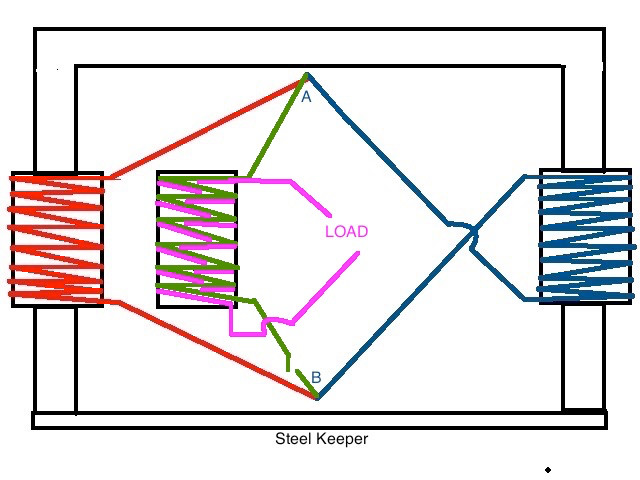Originally posted by Turion
Nice Thread Turion!!
Many thanks for disclosing this material here!
And yes, it does work indeed...a CLOSED/FULL CORE (Basically a TOROID) would do even better than just a small "keeper" plate.
It is very well known that square or any sharp angled cores (like a typical E-I Transformer Frame) would loose Magnetic Field, right at those sharp angles...
Magnetic Field existing at a closed core indefinitely will generate an Electric Field on the previously exciting coil, until closed flux loop frame is opened.
I particularly like your schematic#3...have you ever tried to make a small motor out of this circuit?
I believe with all the four coils above (and of course a different distribution) we could make a nice small motor where the switch would be a small 3 element commutator plus a couple of brushes to close circuit at a particular angle where a constant (perpetual?) rotation could be produced..

Anyways that was just a "fly by idea" that came to my mind when I saw your circuit #3...
But about the main idea, I believe you are completely right for it being used on the TPU main principle.
IMHO, I believe that Cook's and Figuera's ideas on their Patents were missing this important factor of keeping the cores closed and maybe distribute them in "MODULES" which could be connected together just as batteries to add up bigger energy outputs...but maybe they did it on purpose, not to show a FULL PATENT Diagram...idk and guess no one will ever know the truth.
That is the reason why, now I am building a toroidal structure for the Figuera generator primary-secondary Cores...which would eventually be just "one module"...
Back on your idea...I believe that reminiscent field generating a continuous flux around the closed core would do create an Electric Field(EF) indeed...However, I believe that EF besides being weak, it will eventually decay over time SINCE We are not EXCITING anymore the Magnetic Field which actually was the one who originated the EF ("Excitement" as "producing a CHANGE" paraphrasing Faraday Induction Law)...
But parting from the main principle, that we have a Permanent Magnetic Field within a Closed Core, even being "stationary" (meaning not excited, not "changing")...I believe that creating even a small "change" would be very cheap "to pay for" with very high expectancy on the output...and of course, backed up by Caps to make an LC Closed Tank Circuit...etc,etc.
I believe here, you have simply "touched" the really HOT BUTTON, that could trigger the Free Energy Generation!!
Thanks again.
Ufopolitics






 can you put that in laymanís terms?
can you put that in laymanís terms?

Comment